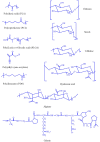Perspective highlights on biodegradable polymeric nanosystems for targeted therapy of solid tumors
- PMID: 28546953
- PMCID: PMC5439389
- DOI: 10.15171/bi.2017.07
Perspective highlights on biodegradable polymeric nanosystems for targeted therapy of solid tumors
Abstract
Introduction: Polymeric nanoparticles (NPs) formulated using biodegradable polymers offer great potential for development of de novo drug delivery systems (DDSs) capable of delivering a wide range of bioactive agents. They can be engineered as advanced multifunctional nanosystems (NSs) for simultaneous imaging and therapy known as theranostics or diapeutics. Methods: A brief prospective is provided on biomedical importance and applications of biodegradable polymeric NSs through reviewing the recently published literature. Results: Biodegradable polymeric NPs present unique characteristics, including: nanoscaled structures, high encapsulation capacity, biocompatibility with non-thrombogenic and non-immunogenic properties, and controlled-/sustained-release profile for lipophilic and hydrophilic drugs. Once administered in vivo, all classes of biodegradable polymers (i.e., synthetic, semi-synthetic, and natural polymers) are subjected to enzymatic degradation; and hence, transformation into byproducts that can be simply eliminated from the human body. Natural and semi-synthetic polymers have been shown to be highly stable, much safer, and offer a non-/less-toxic means for specific delivery of cargo drugs in comparison with synthetic polymers. Despite being biocompatible and enzymatically-degradable, there are some drawbacks associated with these polymers such as batch to batch variation, high production cost, structural complexity, lower bioadhesive potential, uncontrolled rate of hydration, and possibility of microbial spoilage. These pitfalls have bolded the importance of synthetic counterparts despite their somewhat toxicity. Conclusion: Taken all, to minimize the inadvertent effects of these polymers and to engineer much safer NSs, it is necessary to devise biopolymers with desirable chemical and biochemical modification(s) and polyelectrolyte complex formation to improve their drug delivery capacity in vivo.
Keywords: Advanced drug delivery systems; Biodegradable polymers; Natural polymers; Synthetic and semi-synthetic polymers; Targeted therapy.
Similar articles
-
Natural biodegradable polymers based nano-formulations for drug delivery: A review.Int J Pharm. 2019 Apr 20;561:244-264. doi: 10.1016/j.ijpharm.2019.03.011. Epub 2019 Mar 6. Int J Pharm. 2019. PMID: 30851391 Review.
-
Recent advances on biocompatible and biodegradable nanoparticles as gene carriers.Expert Opin Biol Ther. 2016 Jun;16(6):771-85. doi: 10.1517/14712598.2016.1169269. Epub 2016 Apr 4. Expert Opin Biol Ther. 2016. PMID: 26998622 Review.
-
Critical Review of Biodegradable and Bioactive Polymer Composites for Bone Tissue Engineering and Drug Delivery Applications.Polymers (Basel). 2021 Aug 6;13(16):2623. doi: 10.3390/polym13162623. Polymers (Basel). 2021. PMID: 34451161 Free PMC article. Review.
-
Prevention of microbial biofilms - the contribution of micro and nanostructured materials.Curr Med Chem. 2014;21(29):3311. doi: 10.2174/0929867321666140304101314. Curr Med Chem. 2014. PMID: 24606506
-
Biodegradable Antibacterial Polymeric Nanosystems: A New Hope to Cope with Multidrug-Resistant Bacteria.Small. 2019 May;15(20):e1900999. doi: 10.1002/smll.201900999. Epub 2019 Apr 8. Small. 2019. PMID: 30957927 Review.
Cited by
-
Multifunctional nanomedicines for targeting epidermal growth factor receptor in colorectal cancer.Cell Mol Life Sci. 2020 Mar;77(6):997-1019. doi: 10.1007/s00018-019-03305-z. Epub 2019 Sep 28. Cell Mol Life Sci. 2020. PMID: 31563999 Free PMC article. Review.
-
Natural polymers as potential P-glycoprotein inhibitors: Pre-ADMET profile and computational analysis as a proof of concept to fight multidrug resistance in cancer.Heliyon. 2023 Aug 24;9(9):e19454. doi: 10.1016/j.heliyon.2023.e19454. eCollection 2023 Sep. Heliyon. 2023. PMID: 37662819 Free PMC article.
-
Polymeric Nanocarriers of Drug Delivery Systems in Cancer Therapy.Pharmaceutics. 2020 Mar 25;12(4):298. doi: 10.3390/pharmaceutics12040298. Pharmaceutics. 2020. PMID: 32218326 Free PMC article. Review.
-
Synthesis of Cerium Oxide Nanoparticles Using Various Methods: Implications for Biomedical Applications.Nanomaterials (Basel). 2020 Jan 29;10(2):242. doi: 10.3390/nano10020242. Nanomaterials (Basel). 2020. PMID: 32013189 Free PMC article. Review.
-
Stimulus-Responsive Sequential Release Systems for Drug and Gene Delivery.Nano Today. 2020 Oct;34:100914. doi: 10.1016/j.nantod.2020.100914. Epub 2020 Jul 2. Nano Today. 2020. PMID: 32788923 Free PMC article.
References
-
- Omidi Y, Barar J, Heidari HR, Ahmadian S, Yazdi HA, Akhtar S. Microarray analysis of the toxicogenomics and the genotoxic potential of a cationic lipid-based gene delivery nanosystem in human alveolar epithelial a549 cells. Toxicol Mech Methods. 2008;18:369–78. doi: 10.1080/15376510801891286. - DOI - PubMed
-
- Omidi Y, Hollins AJ, Benboubetra M, Drayton R, Benter IF, Akhtar S. Toxicogenomics of non-viral vectors for gene therapy: a microarray study of lipofectin- and oligofectamine-induced gene expression changes in human epithelial cells. J Drug Target. 2003;11:311–23. doi: 10.1080/10611860310001636908. - DOI - PubMed
Publication types
LinkOut - more resources
Full Text Sources
Other Literature Sources


